Artillery in Canada (7) New Brunswick: Saint John, and HMCS Brunswicker
Artillery preserved in New Brunswick
Artillerie préservée au Nouveau-Brunswick
Saint John, and HMCS Brunswicker
The aim of this website is to locate, identify and document every historical piece of artillery preserved in Canada. Many contributors have assisted in the hunt for these guns to provide and update the data found on these web pages. Photos are by the author unless otherwise credited. Any errors found here are by the author, and any additions, corrections or amendments to this list of Guns and Artillery in Canada would be most welcome and may be e-mailed to the author at [email protected].
For all official data concerning the Royal Regiment of Canadian Artillery, please click on the link to their website:
Royal Regiment of Canadian Artillery Website
Note: Back in the day, artillery in Canada was referred to by its radio call sign "Sheldrake". It is now referred to by its "Golf" call sign. (Acorn sends)
Une traduction au français pour l'information technique présente serait grandement apprécié. Vos corrections, changements et suggestions sont les bienvenus, et peuvent être envoyés au [email protected].
New Brunswick
Saint John



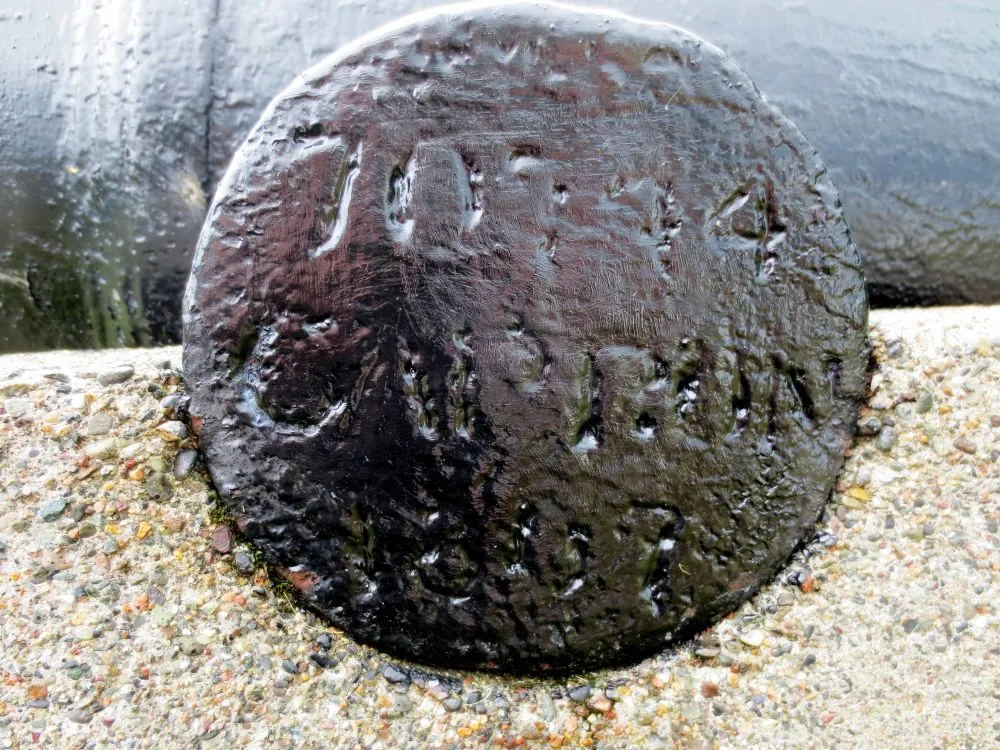
(Author Photos)
Blomefield Cast Iron 32-pounder 56-cwt Smoothbore Muzzleloading Gun, weight 56-3-4 (6,360 lbs), under the cascabel, The Carron Company of Falkirk, Scotland (Serial No. 70744, CARRON, 1807) on left trunnion, (32P) on right trunnion, King George III cypher, broad arrow mark, CV, mounted on a concrete stand, Fernhill Cemetery Naval Memorial, No. 1 of 2 on the West side. This gun came from the Red Head Battery.



Blomefield Cast Iron 32-pounder 56-cwt Smoothbore Muzzleloading Gun, weight 56-3-3 (6,359 lbs) under the cascabel. The Carron Company of Falkirk, Scotland (Serial No. corroded, CARRON, 1807) on left trunnion, (32P) on right trunnion, King George III cypher, broad arrow mark, CV, mounted on a concrete stand, Fernhill Cemetery Naval Memorial, No. 2 of 2 on the East side. This gun also came from the Red Head Battery.
The Blomefield Cast Iron 32-pounder 56-cwt Smoothbore Muzzleloading Gun has a length of 9 feet 6 inches. It is the most common 32-pounder in Canada and can be recognized by a reinforcing ring that is slightly raised followed by a definite "step-down" in the barrel just forward of the trunnions heading to the muzzle.
The 1895 Militia Report includes two 32-pounder 63-cwt Guns in Saint John. Other guns in Saint John at that time included one Blomefield Cast Iron 32-pounder 55.5-cwt Gun, one Blomefield Cast Iron 32-pounder 48-50-cwt Gun and five other Blomefield Cast Iron guns that were converted 24-pounder guns, 25-cwt, 32-cwt, 40-cwt, 41-cwt, and 46-cwt. There were no 70-cwt guns There were four Millar Cast Iron 32-pounder guns, the largest of which was 63-cwt. There were two Dundas Cast Iron 32-pounder guns, the largest of which was 58-cwt. According to the Militia report, Saint John also had two (probable Millar pattern Cast Iron 8-inch 65-cwt Smoothbore Shell Guns, and two Millar pattern Cast Iron 68-pounder 95-cwt Smoothbore Guns. These guns were all most likely part of the collection scrapped in 1942. Doug Knight.
Bronze 3-pounder 3-cwt Smoothbore Muzzleloading Gun, weight 3-0-1 (337 lbs), J & H (John & Henry King), 1799, previously in the Carleton Martello Tower, now with Fort Beauséjour.
Bronze 3-pounder 3-cwt Smoothbore Muzzleloading Gun, stamped J & H King, 1800, previously in the Carleton Martello Tower, now with Fort Beauséjour.
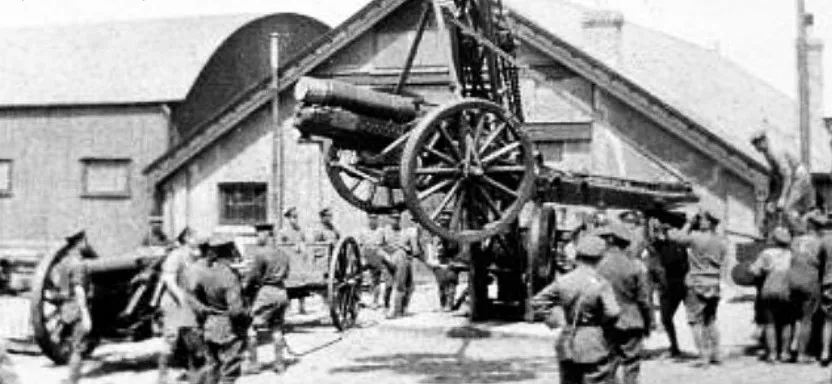
Canadian Gunners with the 3rd Siege Battery unloading a 6-inch BL 26-cwt Breechloading Mk. I Howitzer in England, ca 1917. (Photo by R.J.G. Boyd, a gunner who served with the 3rd Siege Battery, also known as "Cape's Battery", from mid 1915 until 31 March 1917, courtesy of Boyd Roberton)


(Author Photos)
6-inch 26-cwt Breechloading Mk. I Howitzer, Reg No. 3237, manufactured at Vickers, Sons and Maxim (VSM) in 1918. It was mounted on carriage No. C2294. The current serial number for the carriage cannot be clarified, but could be C2285, CA920 or C332845. The howitzer had been on display beside the Fort Howe Block House overlooking the harbour of Saint John, but has been completely refurbished. The howitzer was dedicated in 1974 by the Artillery Association and again after being restored and transferred to the Loyal Company Association and the 3rd Field Regiment in Saint John. Joe Jordan, a retired master gunner and chief warrant officer, oversaw the project. The Howitzer is currently on display at Harbour Station.
Other BL 6-inch howitzers that served in Saint John but have been scrapped included: Reg. No. 373, VSM 18, carriage Reg. No. 14770, allocated to 6 Medium Battery in 1933; Reg. No. 616, VSM 18, carriage Reg. No. CA14840, VSM 18, allocated to 4 Medium Battery in 1933; Reg. No. 2916, VSM 18, carriage Reg. No. 921, allocated to 6 Medium Battery in 1933; and Reg. No. 3489, PESW 17, carriage Reg. No. A927, VSM 18, allocated to 4 Medium Battery in 1933.







(Photos courtesy of Peter Hanlon)
These numbers have come to light as the restoration of the gun was in progress. Peter spoke with the lead hand on the rebuild and he mentioned that very few pieces needed to be replaced (or re-manufactured), the only noticeable ones being the wheels. He did not have time to make new wooden wheels and so went with the rubber ones that were on it. There were a few bolts he replaced and there is a spindle in the sight that is too corroded to save and must be manufactured.
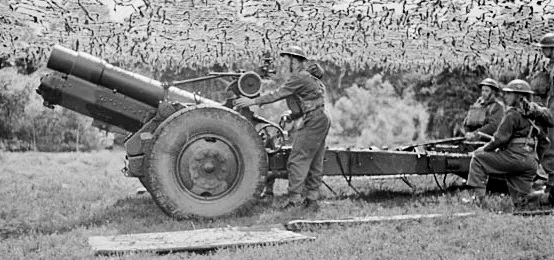
(Library and Archives Canada Photo, MIKAN No. 3607576)
Ordnance BL 6-inch 26-cwt Howitzer in service.
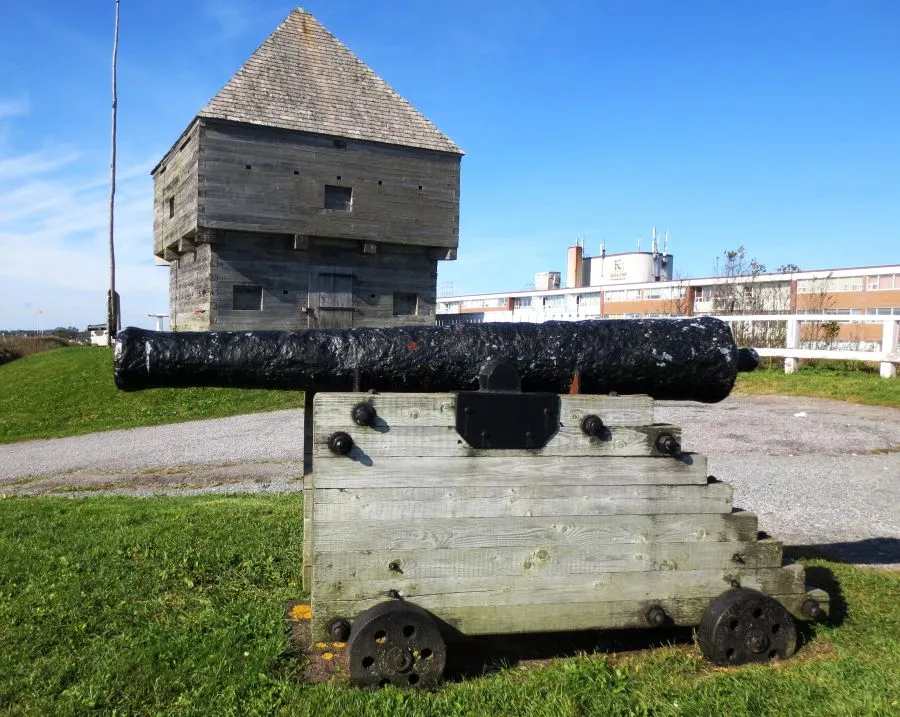
(Author Photo)
Cast Iron Smoothbore Muzzleloading Gun severely corroded, no markings visible, mounted on wooden stand, East of the Fort Howe Block House.

Cast Iron Smoothbore Muzzleloading Gun severely corroded, no markings visible, mounted on wood naval gun stand, West of the Fort Howe Block House.


(Col Cmdt RCA Photos)
Standing Ready monument in Saint John.
105-mm C2 Howitzer.

(Library and Archives Canada Photo, MIKAN No. 3205726)
L/Bdr D. Robertson, Sgt W. Malcolm, Gunner R. Flemming and Gunner J. Gaudet (left to right), Royal Canadian Horse Artillery (RCHA), ready to fire 25-pounder, 26 Sep 1951.
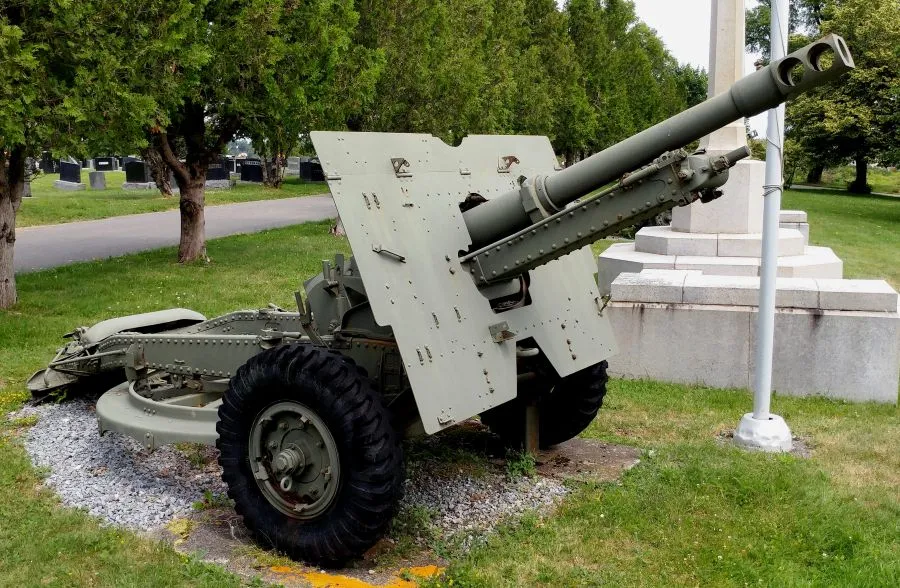
(Author Photo)
25-pounder C Mk. 2 QF Field Gun with No. 9 circular firing platform, No. 1 of 2 at the cenotaph, Cedar Hill Cemetery on Manawagonish Road.
%20(2).webp)
(Author Photo)
25-pounder C Mk. 2 QF Field Gun with No. 9 circular firing platform, No. 2 of 2 at the cenotaph, Cedar Hill Cemetery on Manawagonish Road.

5.5-inch BL Mk. III Gun on a Mk. I Carriage, RCA, south of Vaucelles, France, 23 July 1944. (Library and Archives Canada Photo, MIKAN No. 3396146)





5.5-inch BL Mk. III Gun on a Mk. I Carriage, weight 1-14-1-0 (12,000 + 1,568 + 28 = 13,624 lbs), Jervis Bay Park. Canada made carriages for these guns during the Second World War, and after the war acquired 85 of them for the RCA. There were four marks of 5.5 inch ordnance although only 3 and, after the Second World War, 4 entered service, and the differences were only minor. There were two marks of carriage where the differences were greater use of welding and less of riveting. The carriages were identical to those used with Ordnance BL 4.5 inch Mark 2. No limber was ever used and the gun fired with its wheels in contact with the ground. Initially, the 5.5 inch gun fired a 100-pound (45 kg) shell, using four charges in two cartridges to give a maximum range table muzzle velocity of 1,675 feet per second (511 m/s) and a maximum range of 16,200 yards (14,800 m).

40-mm Bofors Light Anti-Aircraft Gun, 53rd Bty, 3rd Light Anti-Aircraft Regiment, RCA, Bexhil, England, 10 Jun 1942. (Library and Archives Canada Photo, MIKAN No. 3229979)

(City of Vancouver Archives Photo, AM1184-S3-: CVA 1184-629)
40-mm Bofors Light Anti-Aircraft Gun, University Point, British Columbia, 1943.

40-mm Bofors Light Anti-Aircraft Gun, St. Joseph’s Cemetery. This gun belongs to the RCA Museum, CFB Shilo, Manitoba. It was loaned to 3 Field Regiment for its 1993 bicentennial celebration. Harold Wright.
Gun Battery positions at Partridge Island.
There were several large guns with the Partridge Island Battery which were still in the RCA Gun Battery postions in 1939. It is likely they were melted down post 1942. The Signal Gun was still there in 1945, but buried some time later. About 1987 Harold Wright dug it up after being given ownership by the Coast Guard. Unfortnately, the gun was removed before it could be collected and restored, and its current location is unknown. Harold Wright.
Saint John, HMCS Brunswicker
HMCS Brunswicker is a Canadian Forces Naval Reserve (NRD). Dubbed a stone frigate, HMCS Brunswicker is a land-based naval training establishment crewed by part-time sailors and also serves as a local recruitment centre for the Canadian Forces Naval Reserve and the RCN. It is one of 24 naval reserve divisions located in major cities across Canada.
This division was established in 1923 as a full company of 100 sailors of the Royal Naval Canadian Volunteer Reserve (RNCVR). In 1927 the division was reduced to a half-company of 50, training sailors in basic seamanship skills such as semaphore and rope work throughout the interwar period.
HMCS Brunswicker was commissioned in 1941. During the Second World War, HMCS Brunswicker served as the primary recruiting and training establishment for the RCN in the province of New Brunswick. The division was in an annex of the Barrack Green Armoury in South Saint John. A new facility situated on the city waterfront was built for the division in 1995.
On 6 June 2019, HMCS Brunswicker expanded to open a satellite sub-unit in Moncton. In December 2019 HMCS Brunswicker was awarded the Fenco-MacLaren Trophy by the Commander of the Naval Reserve for its innovative support to the Naval Reserve's core mission of recruiting and retention with the opening of the satellite location.
Currently, HMCS Brunswicker trains sailors and teams for Canadian Armed Forces (CAF) domestic and international operations, while at the same time supporting the Navy's efforts in connecting with Canadians through the maintenance of a broad national presence. Reservists employed at HMCS Brunswicker are individuals who are otherwise engaged in full-time civilian careers while pursuing a part-time military career as an officer or non-commissioned member. They train and work for the Navy in the evenings, on weekends and during the summer period. Most serve on a part-time basis, with no obligation to participate in any mission overseas. However, many full-time employment opportunities and deployments are available to those Reservists who volunteer for them.

Cast Iron Smoothbore Swivel Gun, 17th Century, recovered from Fort La Tour, on display inside the main lobby.
Although this type of gun has always been thought to be quite early, some work Kay Smith Brown did a few years ago shows that they were actually made from the late 16th century and through the 17th century. They were made all over Europe though, from the evidence we have at the moment, they appear to be a northern European speciality. A very similar gun, with a cast
bronze barrel, and called a pertriera a braga or a musquet de braga, were a speciality of southern Europe, especially Italy. Do note that museum catalogues, especially old ones, are not always accurate and it is the work from modern work derived from nautical archaeology that has allowed us to be accurate about their dating.
They are not cast but built up from components made from wrought iron and have a very complex design so that, although they look simple (and to some eyes, crude) they are very sophisticated. Wrought-iron guns were actually used throughout Europe until the first decade of the 18th century.
They are, in English sources, called murderers, and were used as anti-personnel weapons especially on ships. Before the
20th century the aim of ship warfare was to kill the crew and capture the ship, not sink it - it was worth a fortune in bounty. Anti-personnel weapons were an important part of a ship's armament. For chapter and verse see Kay Smith Brown's article ‘Wrought-iron swivel guns’. In M Bound (ed) The Archaeology of Ships of War. Oswestry, 1995.
It is still a very important and a very early piece in North America. Incidentally there is a similar gun in the Met in New York and one in the Stewart Museum in Montreal.
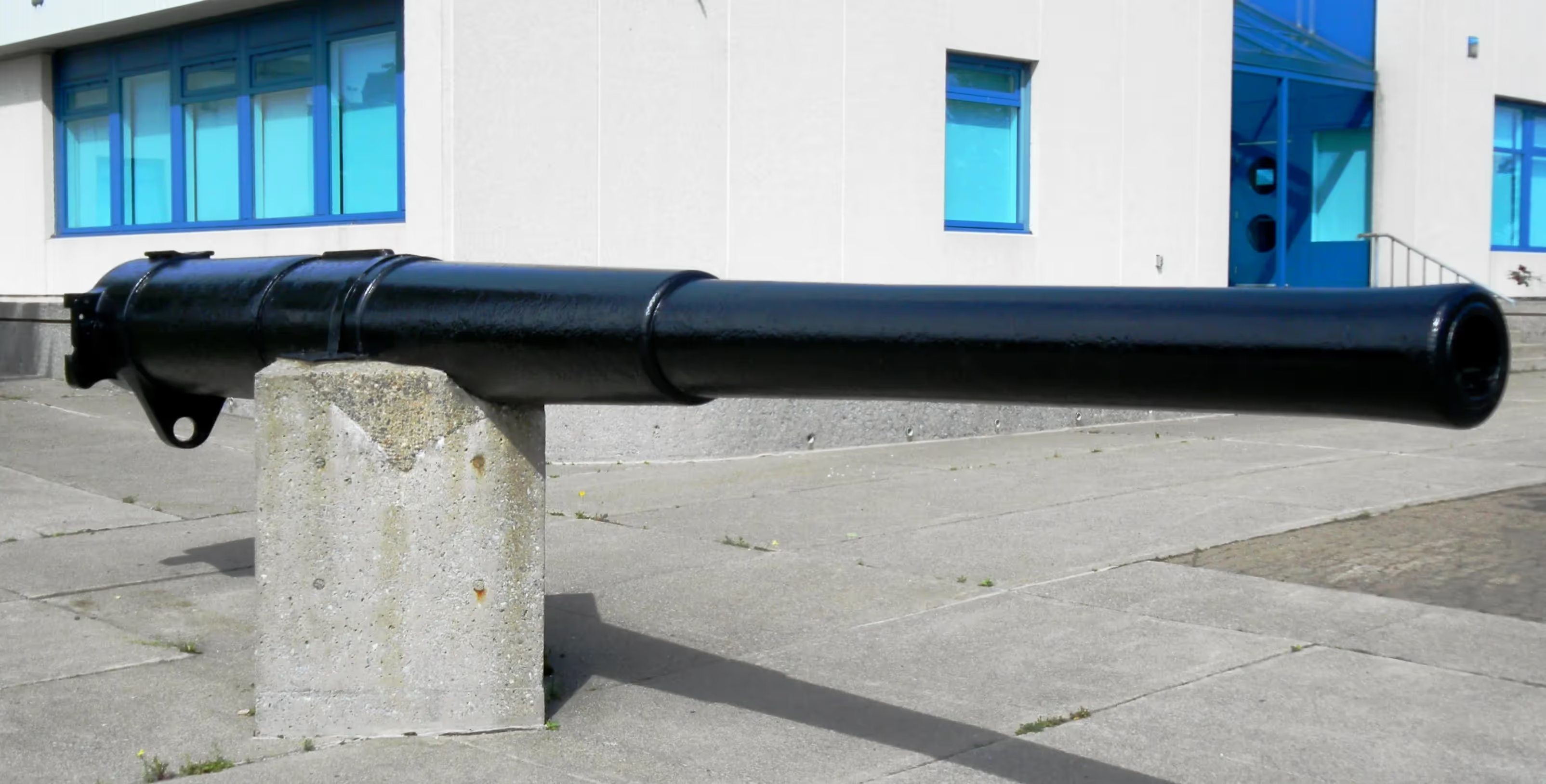


6-inch H.E.D.C. Mk. II Breechloading Gun, HMCS Niobe. 160 Chesley Drive. Two 6-inch guns from HMCS Niobe were used as Coast Defence guns on Partridge Island, Saint John, during the Second World War. They were obtained by the Partridge Island Research Project in 1982. In 1982 the barrels were dedicated to the gunners and sailors who manned the guns during the war, and again in 1985 during Saint John's Bicentennial. The barrels were returned to the Crown in 2009. Harold Wright.
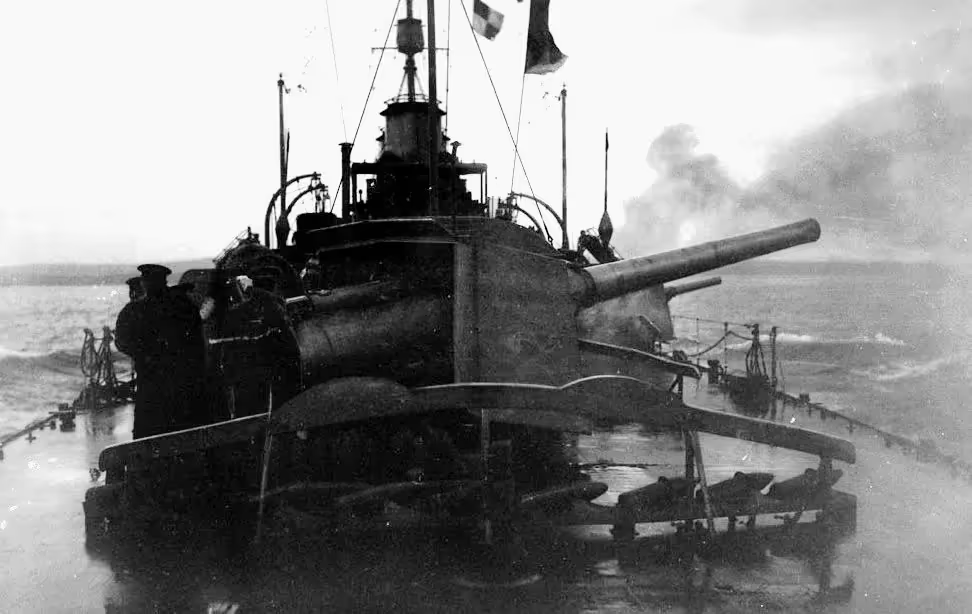
(Library and Archives Canada Photo, MIKAN No. 3404655)
6-inch Breechloading Naval Gun on board HMS Royalist, Feb 1917.

(Library and Archives Canada Photo, MIKAN No. 3199286)
6-inch Breechloading Naval Gun being examined by Royal Canadian Navy sailors in an American harbour in Sep 1940.

(IWM Photo, H3124)
6-inch Breechloading Naval Gun with protective shield, overlooking Reykjavik Bay in Iceland, August 1940.
Saint John, 3rd Field Artillery Regiment, RCA
The 3rd Field Artillery Regiment, The Loyal Company, is a Primary Reserve Royal Canadian Artillery (RCA) regiment with a Regimental Headquarters (RHQ) and two Batteries (Bty). The RHQ and one Bty are located in Saint John, at the Barrack Green Armoury, 60 Broadview Ave. Its second Bty, the 89th Field Battery is located in Woodstock. The 3rd Field Artillery Regiment provides indirect fire support (guns and mortars) to the Army.

The current primary piece of artillery in service with 3rd Field Artillery Regiment is the C3 105-mm Howitzer.
On May 4, 1793, the Loyal Company was formed in Saint John in response to the threat of attack by French privateers. In 1838 all artillery Batteries around the province were constituted into the New Brunswick Regiment of Artillery. This makes the Regiment the oldest continuous serving artillery unit in Canada.
The Regiment manned local defences during the War of 1812. Gunners volunteered for service during the Aroostook, or 'Pork 'n Beans' war. In 1866, the St. Andrews Battery, under Captain Osborn, was reformed in preparation against a Fenian attack. In June 1866, Captain Pick's Battery manned the guns at Partridge Island to defend Saint John from Fenian attack. The Carleton Martello Tower and Sand Cove beach were also defended.
The Regiment was placed on active service during the Great War 1914-1918. Over 2000 gunners were sent overseas, including the 3rd Brigade, Canadian Garrison Artillery (CGA), Canadian Expeditionary Force (CEF), No. 4 Canadian Siege Battery, CEF, No. 6 Canadian Siege Battery, CEF, the 2nd Divisional Ammunition Column, and re-enforcement drafts of the 9th Siege Battery.
The 3rd (New Brunswick) Coast Brigade, RCA (The Loyal Company of Artillery) was called out on service for local protection duties on 26 August 1939. Details from the brigade were also mobilized for active service under the designation 3rd (New Brunswick) Coast Brigade, RCA, CASF (Details) on 1 September 1939. The details called out on active service were disbanded on 31 December 1940 and the brigade mobilized an active service unit designated 3rd (New Brunswick) Coast Brigade, RCA, CASF on 1 January 1941. It was redesignated 3rd (New Brunswick) Coast Regiment, RCA, CASF on 1 August 1942. The regiment provided coastal artillery support as part of the defences of Saint John, New Brunswick. The regiment was disbanded on 1 September 1944.
3rd (New Brunswick) Medium Anti-Aircraft Regiment, RCA
Originated 28 May 1869 in Saint John, New Brunswick, as the New Brunswick Brigade of Garrison Artillery.
Redesignated 1 January 1893 as the New Brunswick Battalion of Garrison Artillery.
Redesignated 1 January 1895 as the 3rd "New Brunswick Battalion" of Garrison Artillery.
Redesignated 28 December 1895 3rd "New Brunswick" Regiment of Garrison Artillery.
Redesignated 2 April 1907 as the 3rd "New Brunswick" Regiment (Heavy Brigade).
Redesignated 2 May 1910 as the 3rd "New Brunswick" Heavy Brigade, Canadian Garrison Artillery.
Redesignated 15 April 1912 as the 3rd "New Brunswick" Regiment, CGA.
Redesignated 2 February 1920 as the 3rd (New Brunswick) Heavy Brigade, CA.
Redesignated 9 1 July 1925 as the 3rd (New Brunswick) Medium Brigade, CA.
Redesignated 1 March 1930 as the 3rd (New Brunswick) Medium Brigade, CA (The Loyal Company of Artillery).
Redesignated 3 June 1935 as the 3rd (New Brunswick) Medium Brigade, RCA (The Loyal Company of Artillery).
Redesignated 15 April 1938 as the 3rd (New Brunswick) Coast Brigade, RCA (The Loyal Company of Artillery).
Redesignated 7 November 1940 as the 3rd (Reserve) (New Brunswick) Coast Brigade, RCA (The Loyal Company of Artillery).
Redesignated 21 September 1945 as the 3rd (Reserve) (New Brunswick) Coast Regiment, RCA (The Loyal Company of Artillery).
Redesignated 1 April 1946 as the 3rd (New Brunswick) Coast Regiment, RCA.
Redesignated 29 April 1948 as the 3rd (New Brunswick) Heavy Anti-Aircraft Regiment, RCA.
Redesignated 22 August 1955 as the 3rd (New Brunswick) Medium Anti-Aircraft Regiment, RCA.
Amalgamated 1 September 1959 with the 23rd Medium Anti- Aircraft Regiment, RCA, retaining its designation as the 3rd (New Brunswick) Medium Anti-Aircraft Regiment, RCA.
Redesignated 12 April 1960 as the 3rd (New Brunswick) Medium Anti-Aircraft Artillery Regiment, RCA.
Redesignated 10 December 1962 as the 3rd Field Artillery Regiment (The Loyal Company), RCA.
Redesignated 20 November 1975 as the 3rd Field Artillery Regiment, RCA.
23rd Medium Anti-Aircraft Regiment, RCA
Originated 15 February 1924 in Saint John, New Brunswick as the 9th Mounted Brigade Headquarters.
Converted 15 December 1936 to artillery and redesignated as the 23rd Field Brigade, RCA.
Redesignated 7 November 1940 as the 23rd (Reserve) Field Brigade, RCA.
Redesignated 1 September 1943 as the 23rd (Reserve) Field Regiment, RCA.
Redesignated 1 April 1946 as the 23rd Heavy Anti-Aircraft Regiment, RCA.
Redesignated 22 August 1955 as the 23rd Medium Anti-Aircraft Regiment, RCA.
Amalgamated 1 September 1959 with the 3rd (New Brunswick) Medium Anti-Aircraft Regiment, RCA.



(Author Photos)
6-inch H.E.D.C. Mk II Breechloading Gun, HMCS Niobe. This gun barrel was restored and refurbished in 2012, and is placed facing the Bay of Fundy in front of the Armoury. These two guns were mounted and dedicated as memorials to the men of HMS/HMCS Niobe and the Gunners who served them on Partridge Island during the Second World War. In 2009 the barrels were transferred from the Partridge Island Research Project to the Federal Crown, and they are currently on display with HMCS Brunswicker and 3 Field Regiment. Neither 3 Fd nor Brunswicker own the barrels. Harold Wright.
Saint John, New Brunswick Museum, 1 Market Square.
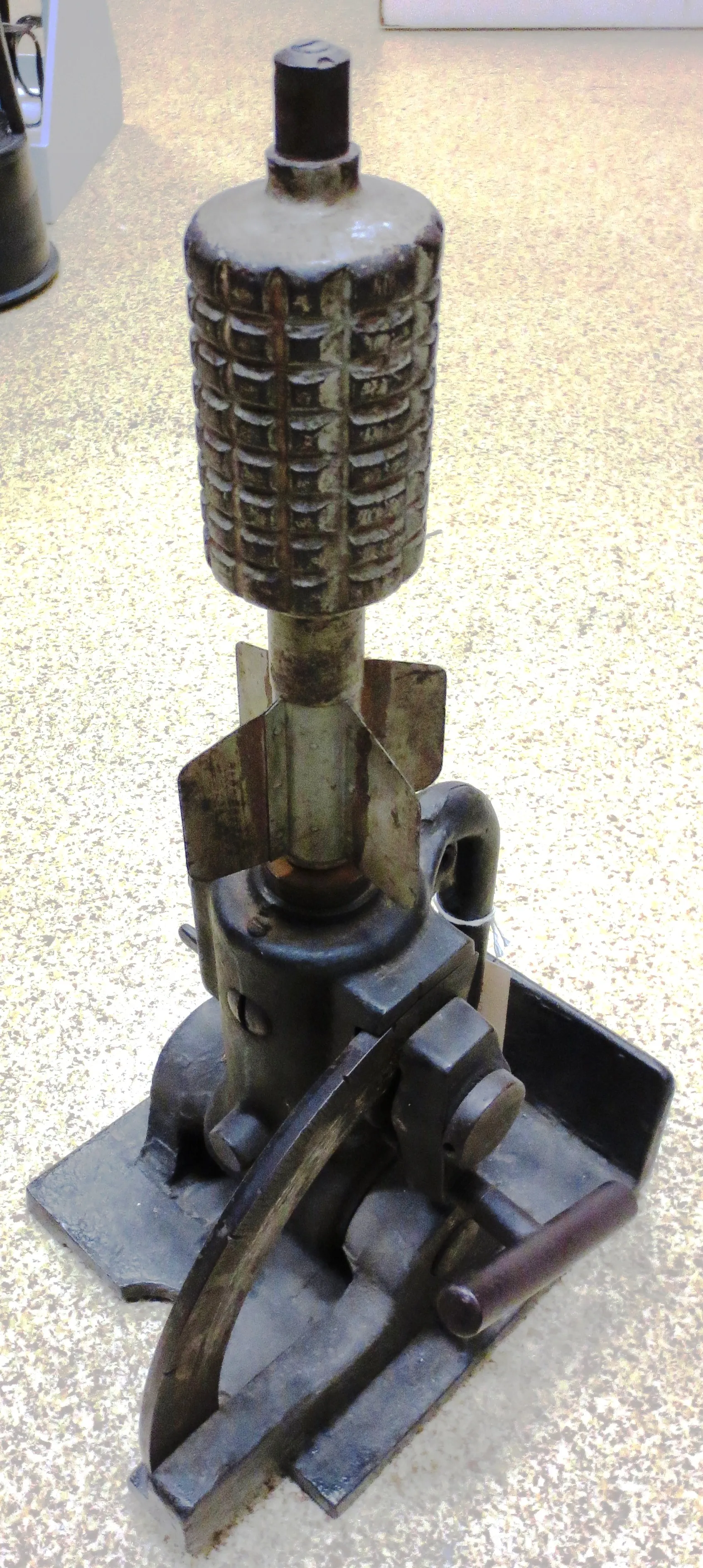
(Author Photo)
German First World War Granatenwerfer 16 spigot mortar, (Serial Nr. TBC), with grenade mounted. This trench mortar was likely captured ca 1918 by a Battalion of an Infantry Brigade in a Canadian Division with the Canadian Expeditionary Force (CEF), in France.
Saint John, Royal Kennebecassis Yacht Club

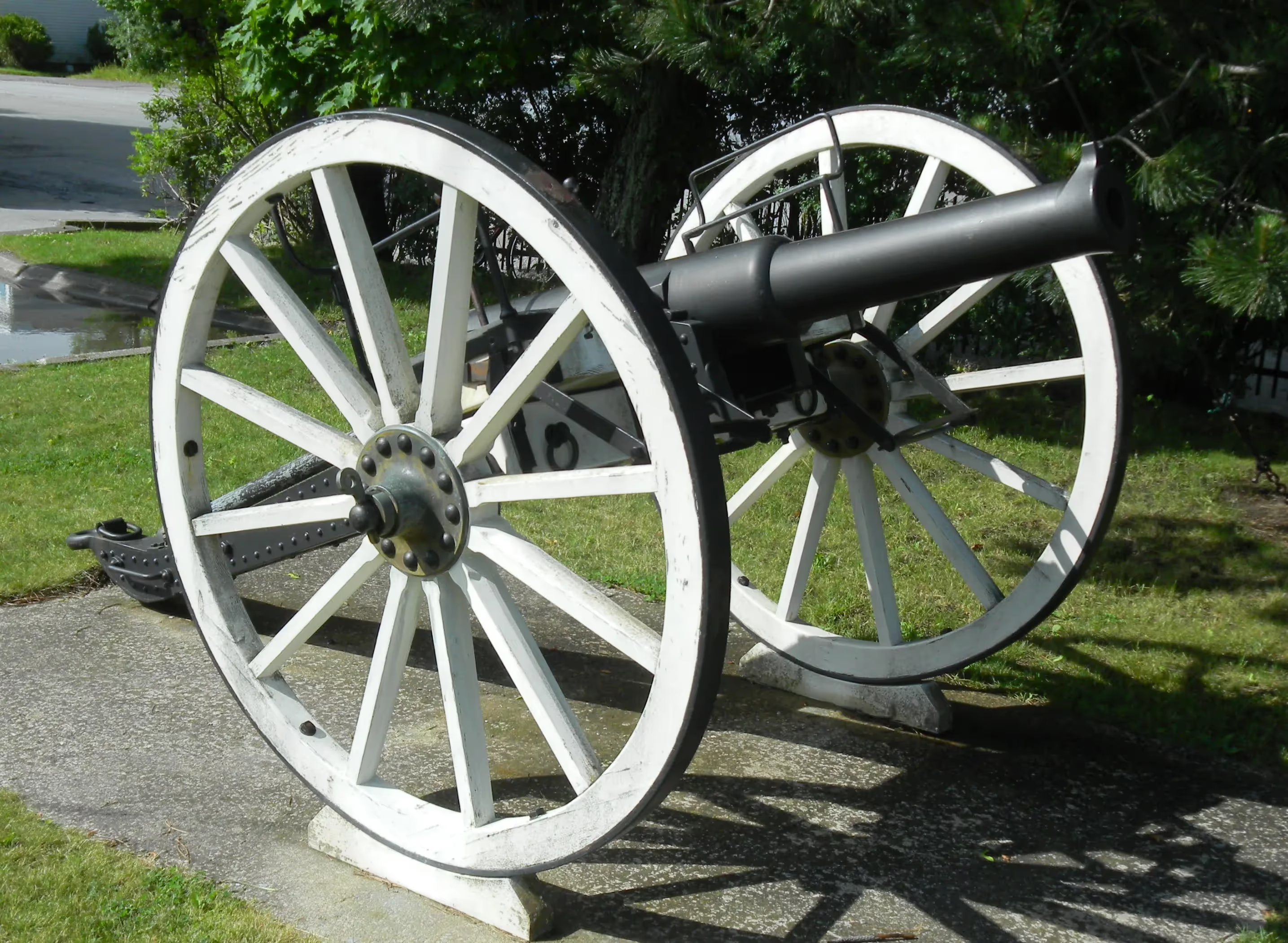


9-pounder 8-cwt Muzzleloading Rifle, weight 8-1-1 (925 lbs), stamped 1873, I, mounted on an iron field carriage, stamped RCD 1873, No. 92, Sir W.G. Armstrong and Co., Newcastle on the Tyne. 1042 Millidge Ave.
Cast Iron 12-pounder 6-cwt Smoothbore Muzzleloading Carronade with a Blomefield-pattern breeching ring, weight corroded, mounted on a wood naval gun carriage, Royal Kennebecassis Yacht Club, 1042 Millidge Ave., Saint John, NB.





